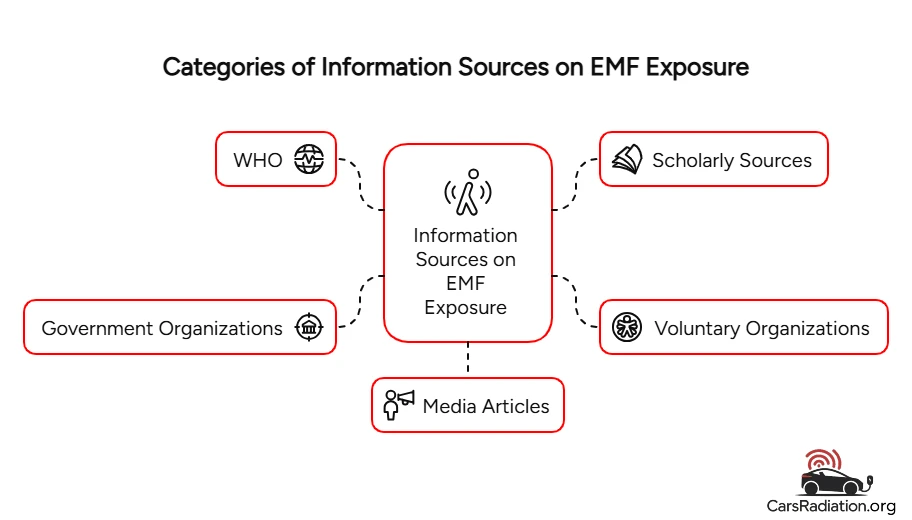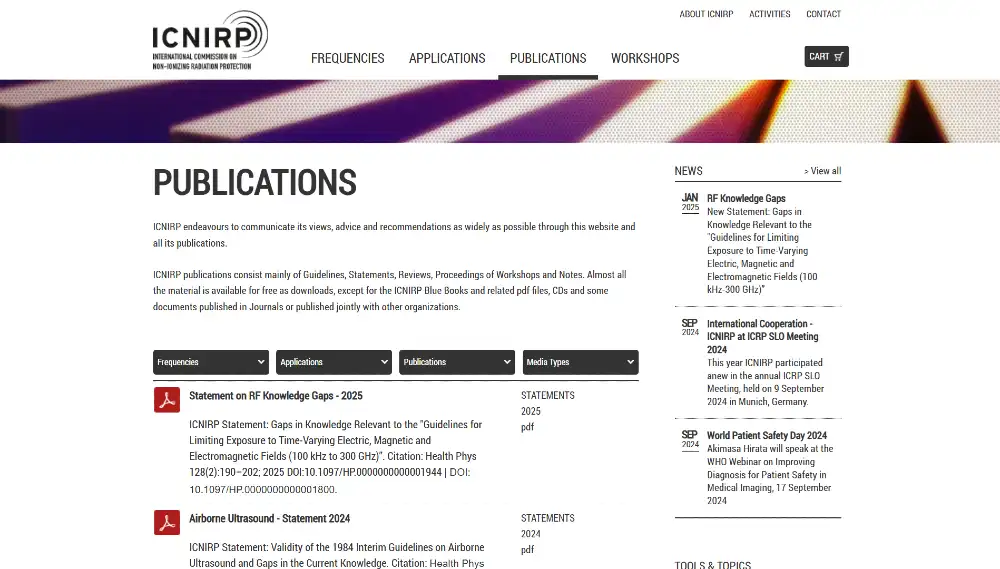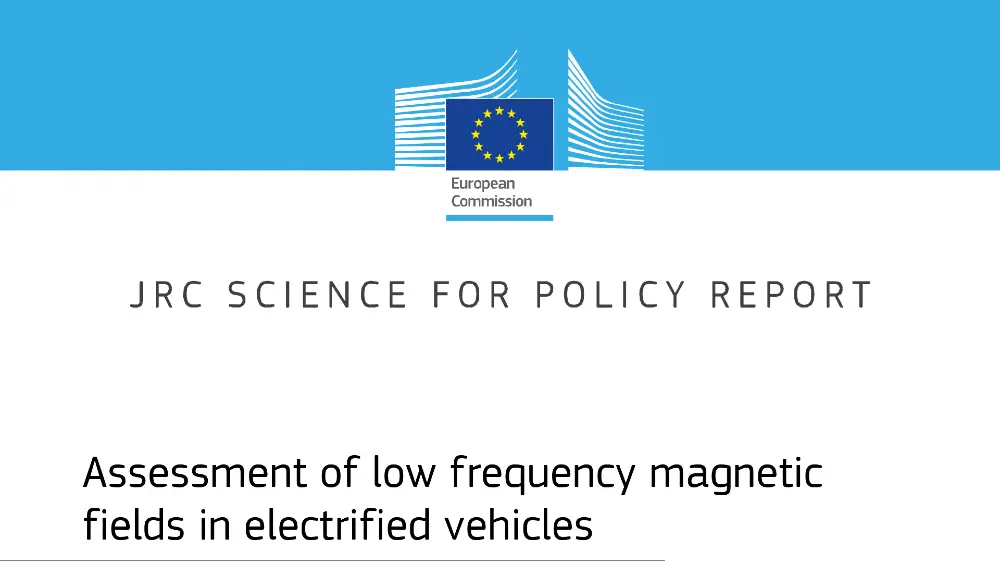Information Sources on EMF Exposure in Cars

The increasing electrification and digitization of vehicles have introduced new operational capabilities, but also raised questions regarding occupant exposure to electromagnetic fields (EMFs). In particular, electric and hybrid vehicles employ high-voltage drive systems, complex power electronics, and multiple wireless communication subsystems. These components emit various forms of non-ionizing electromagnetic radiation.
The subject of EMF exposure in vehicles, while technical in nature, has direct implications for public health, regulatory frameworks, and informed consumer decision-making. Identifying accurate and scientifically grounded sources of information is important not only for individuals seeking to assess potential risks, but also for policymakers tasked with defining exposure thresholds and mitigation strategies.
Overview of Radiation in Vehicles
Electromagnetic radiation encountered in vehicles falls under the category of non-ionizing fields. These include:
- Static magnetic fields generated by permanent magnets or DC current.
- Extremely low frequency (ELF) magnetic fields, typically in the tens to hundreds of Hz range, originating from AC power conversion and drive circuitry.
- Radiofrequency (RF) fields emitted by wireless communication modules (Bluetooth, GPS, Wi-Fi, etc.).
Unlike ionizing radiation, which can cause direct molecular or DNA-level disruption, non-ionizing EMFs lack sufficient photon energy to break chemical bonds. However, growing scientific discourse points to biological interactions from long-term exposure, particularly under conditions of close proximity and limited shielding, both of which are characteristic of the vehicular environment.
While most current emissions comply with established guidelines for “acute” (short duration) exposure, several studies indicate that uncertainty remains regarding chronic effects, especially in scenarios involving prolonged exposure and vulnerable population groups (e.g., children, pregnant women).

Categories of Information Sources
Given the multidisciplinary nature of EMF research and the changing vehicle technologies, it is important to distinguish between types of information sources by their methodological basis and intended audience:
WHO (World Health Organization)
Institutional Role
As a leading international authority on public health, the World Health Organization (WHO) collaborates with institutions including the International Commission on Non-Ionizing Radiation Protection (ICNIRP) to develop standardized EMF exposure guidelines. These frameworks are frequently adopted as a baseline for national regulations and automotive industry compliance.
Relevant Guidance
Of particular significance is Environmental Health Criteria 238, a WHO publication focused on Extremely Low Frequency Fields (ELF). The document outlines:
- Characterization of EMF sources relevant to public and occupational settings
- Biological interaction pathways based on current experimental data
- Risk analysis concerning potential outcomes, including carcinogenicity, neurodegeneration, and reproductive disruption
These guidelines inform policy decisions, set exposure benchmarks, and are frequently cited by regulatory bodies worldwide.
Access Pathways
WHO documentation is publicly accessible via WHO.int. In addition to full technical monographs, condensed overviews and graphical summaries are provided. For topic-specific navigation, users should begin with the Electromagnetic Fields and Cancer sections under the Environmental Health domain.
Scholarly Sources
Definition and Relevance
Peer-reviewed academic research offers the highest level of evidentiary rigor for learning about the implications of EMF exposure in automotive environments. Journals such as Sensors and the International Journal of Environmental Research and Public Health have published quantitative and longitudinal studies specifically addressing EMF levels in vehicular contexts.
Primary Research Domains
Scientific studies typically fall into several investigational categories:
- Quantification of extremely low-frequency (ELF) and radiofrequency (RF) magnetic fields within passenger compartments
- Long-duration biological assessments linked to chronic exposure scenarios
- Sociological inquiries into public awareness and behavioral adaptations regarding EMF safety
Data acquisition methodologies range from direct in-vehicle field measurements to controlled laboratory trials and epidemiological tracking.
Access and Evaluation Criteria
To locate credible academic content, platforms such as PubMed, ScienceDirect, and Google Scholar are standard. Articles should be evaluated based on:
- Effect factor of the journal
- Peer-review and editorial board transparency
- Methodological robustness—specifically, statistical validity, sample size, and control conditions
Voluntary Organizations (e.g., ICNIRP)
Role and Scope of Influence
 Voluntary, non-governmental entities such as the International Commission on Non-Ionizing Radiation Protection (ICNIRP) serve an important function in establishing scientifically-derived exposure reference levels for electromagnetic fields (EMFs).
Voluntary, non-governmental entities such as the International Commission on Non-Ionizing Radiation Protection (ICNIRP) serve an important function in establishing scientifically-derived exposure reference levels for electromagnetic fields (EMFs).
Although these organizations are not regulatory by nature, their output is commonly integrated into national and international public health frameworks, including those developed by the World Health Organization (WHO).
ICNIRP operates by convening subject matter experts to evaluate peer-reviewed studies concerning non-ionizing radiation. The outcome of this process is a set of exposure limits designed to mitigate known short-term biological effects. These include, for example, electrostimulation from low-frequency fields and thermal loading from radiofrequency (RF) sources.
The organization does not possess enforcement authority; however, its recommendations often form the basis of statutory or quasi-statutory frameworks adopted by member states and public agencies worldwide.
Exposure Limit Specifications
ICNIRP guidelines provide numeric limits for exposure across a spectrum of electromagnetic field frequencies:
- Static Magnetic Fields (0 Hz)
- Extremely Low Frequency (ELF) Fields (up to 300 Hz)
- Radiofrequency Fields (100 kHz–300 GHz)
These limits are engineered to avoid acute physiological thresholds. The guidelines primarily address immediate, well-characterized effects, such as induced currents or tissue heating, rather than long-term risks since the exact mechanisms of the letter are still being studied and lack consensus on the recommended levels.
Government Organizations (e.g., JRC of the European Union)
Institutional Function
Unlike voluntary bodies, governmental organizations are tasked with translating scientific consensus and precautionary policy recommendations into regulatory frameworks and compliance measures. One prominent entity in this regard is the European Commission’s Joint Research Centre (JRC), which delivers evidence-based technical input to support legislative action, including those related to human exposure to electromagnetic fields.
Example: JRC Assessment of EMF in Electrified Vehicles
 The JRC’s 2020 publication, Assessment of Low Frequency Magnetic Fields in Electrified Vehicles, represents a foundational reference for the systematic evaluation of magnetic field emissions in the context of modern electric mobility. The document includes:
The JRC’s 2020 publication, Assessment of Low Frequency Magnetic Fields in Electrified Vehicles, represents a foundational reference for the systematic evaluation of magnetic field emissions in the context of modern electric mobility. The document includes:
- Methodological evaluation of in-vehicle magnetic field measurements
- Quantitative field strength analysis across various vehicle segments
- Comparative assessments relative to ICNIRP thresholds and European guidance values
The report emphasizes the necessity for continued measurement standardization, exposure modeling over time, and integration of protective design architectures to accommodate vehicle electrification trends.
National-Level Bodies and International Counterparts
Apart from pan-European efforts, individual nations maintain their own oversight bodies. Examples include:
- Germany: Bundesamt für Strahlenschutz (BfS), which oversees health risk assessments and policy consultation regarding EMF exposure from technological sources, including vehicles.
- Israel: Ministry of Health and affiliated research units, which issue precautionary guidelines and conduct exposure monitoring in accordance with evolving scientific and societal standards.
- Switzerland: The Swiss government implements a “precautionary emission control” policy that mandates EMF emissions be kept as low as “technically and operationally feasible.”
- Italy: Italy follows ICNIRP exposure limits but goes further by establishing additional “attention values” and “quality goals” for environments frequented by vulnerable populations, such as schools and residences.
- Australia and New Zealand: Both countries apply a “prudent avoidance” policy, focusing on cost-effective measures to reduce exposure, particularly for power-frequency EMFs near sensitive areas like schools.
- Sweden: Sweden also adopts prudent avoidance strategies and has been active in integrating low-cost EMF mitigation into infrastructure planning, especially in urban environments.
- Canada: The Government of Canada references the precautionary principle in its national environmental and health safety frameworks, including those involving EMF exposure.
In these cases, application of the precautionary principle, particularly under conditions of scientific uncertainty, is often advocated.
Accessibility and Integration into Public Policy
Government reports generated by such institutions typically undergo peer review and are made available to stakeholders and the general public. They often include multilingual versions to facilitate broader access and integration into policy decisions related to infrastructure development, automotive safety standards, and urban planning regulations.
For instance, the complete JRC assessment report can be found via the EU Science Hub. This report includes granular measurement protocols and contextual analysis intended for use by engineers, regulators, and health professionals alike.
Media Articles
Function and Influence
Public awareness regarding electromagnetic radiation in modern vehicles is heavily influenced by media dissemination. Coverage by publications such as Magility has introduced potential health implications of EMF exposure—particularly to vulnerable demographics including children and pregnant women. These articles often serve as a catalyst for broader societal dialogue, albeit with varying levels of technical accuracy.
Common Thematic Elements
Recurring subject matter observed across media coverage includes:
- EMF measurements in newly released electric and hybrid models
- Discussion of possible health outcomes from chronic exposure
- Vehicle design modifications aimed at emission mitigation
- Statements and positions from public health institutions and regulatory agencies
Due to inherent variability in editorial standards and potential biases, consuming content from multiple independent media outlets is advisable. This provides redundancy in fact-checking and supports identification of prevailing narratives.
Evaluating Article Credibility
Several parameters can be used to evaluate the informational reliability of media articles:
- Author credentials and prior publication record
- Citations of peer-reviewed scientific studies or regulatory documentation
- Affiliation of the publisher with recognized academic or regulatory bodies
- Alignment with existing standards published by entities such as WHO or national radiation safety authorities
Comparative Review of Source Types
Here’s a simple and clear table summarizing the comparison of the five source categories:
| Source Type | Strengths | Limitations |
| Media Articles | – Easily accessible – Raise public awareness – Provide early coverage of new issues |
– May sensationalize or oversimplify – Often lack scientific depth or citations |
| World Health Organization (WHO) | – Globally recognized authority – Provides consensus-based health guidelines – Emphasizes vulnerable population protection |
– Slow to reflect newest research – May favor conservative, generalized recommendations |
| Scholarly Sources | – Peer-reviewed and evidence-based – Detailed methodologies – Critical for in-depth scientific understanding |
– May be difficult to understand for general public – Often behind paywalls |
| Voluntary Organizations (ICNIRP) | – Offers scientifically grounded safety standards – Independent of industry and government influence – Widely adopted internationally |
– Focus mostly on short-term effects – Guidelines are non-binding |
| Government Organizations (JRC, etc.) | – Conduct real-world exposure assessments – Influence laws and regulations – Reports often available to public and policymakers |
– May be influenced by political/economic agendas – Policy implementation can be slow |
However, limitations exist across all modalities. An integrative plan mitigates these limitations. For instance, a news article referencing WHO thresholds should be cross-validated against the original publication, and further substantiated through peer-reviewed research.
A detailed understanding of vehicle-related electromagnetic exposure necessitates triangulation across media, institutional, and academic domains. Each provides distinct but complementary insights into the changing discourse on EMF safety. As the global market continues to move toward electric and hybrid vehicles, access to verified, multifactorial data is important both for individual decision-making and regulatory development.

